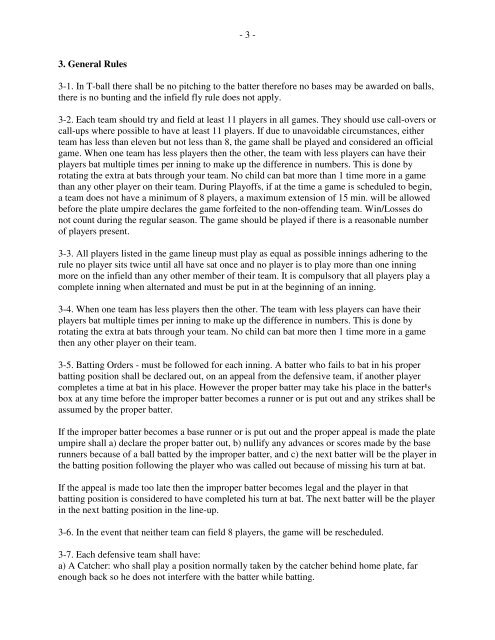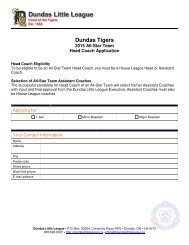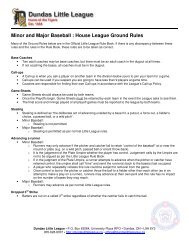Rules of Play - Dundas Little League
Rules of Play - Dundas Little League
Rules of Play - Dundas Little League
You also want an ePaper? Increase the reach of your titles
YUMPU automatically turns print PDFs into web optimized ePapers that Google loves.
- 3 -<br />
3. General <strong>Rules</strong><br />
3-1. In T-ball there shall be no pitching to the batter therefore no bases may be awarded on balls,<br />
there is no bunting and the infield fly rule does not apply.<br />
3-2. Each team should try and field at least 11 players in all games. They should use call-overs or<br />
call-ups where possible to have at least 11 players. If due to unavoidable circumstances, either<br />
team has less than eleven but not less than 8, the game shall be played and considered an <strong>of</strong>ficial<br />
game. When one team has less players then the other, the team with less players can have their<br />
players bat multiple times per inning to make up the difference in numbers. This is done by<br />
rotating the extra at bats through your team. No child can bat more than 1 time more in a game<br />
than any other player on their team. During <strong>Play</strong><strong>of</strong>fs, if at the time a game is scheduled to begin,<br />
a team does not have a minimum <strong>of</strong> 8 players, a maximum extension <strong>of</strong> 15 min. will be allowed<br />
before the plate umpire declares the game forfeited to the non-<strong>of</strong>fending team. Win/Losses do<br />
not count during the regular season. The game should be played if there is a reasonable number<br />
<strong>of</strong> players present.<br />
3-3. All players listed in the game lineup must play as equal as possible innings adhering to the<br />
rule no player sits twice until all have sat once and no player is to play more than one inning<br />
more on the infield than any other member <strong>of</strong> their team. It is compulsory that all players play a<br />
complete inning when alternated and must be put in at the beginning <strong>of</strong> an inning.<br />
3-4. When one team has less players then the other. The team with less players can have their<br />
players bat multiple times per inning to make up the difference in numbers. This is done by<br />
rotating the extra at bats through your team. No child can bat more then 1 time more in a game<br />
then any other player on their team.<br />
3-5. Batting Orders - must be followed for each inning. A batter who fails to bat in his proper<br />
batting position shall be declared out, on an appeal from the defensive team, if another player<br />
completes a time at bat in his place. However the proper batter may take his place in the batter¹s<br />
box at any time before the improper batter becomes a runner or is put out and any strikes shall be<br />
assumed by the proper batter.<br />
If the improper batter becomes a base runner or is put out and the proper appeal is made the plate<br />
umpire shall a) declare the proper batter out, b) nullify any advances or scores made by the base<br />
runners because <strong>of</strong> a ball batted by the improper batter, and c) the next batter will be the player in<br />
the batting position following the player who was called out because <strong>of</strong> missing his turn at bat.<br />
If the appeal is made too late then the improper batter becomes legal and the player in that<br />
batting position is considered to have completed his turn at bat. The next batter will be the player<br />
in the next batting position in the line-up.<br />
3-6. In the event that neither team can field 8 players, the game will be rescheduled.<br />
3-7. Each defensive team shall have:<br />
a) A Catcher: who shall play a position normally taken by the catcher behind home plate, far<br />
enough back so he does not interfere with the batter while batting.





